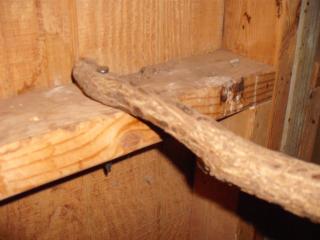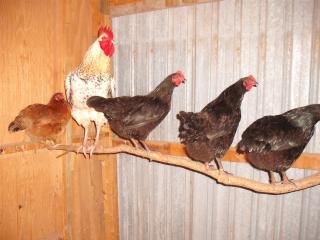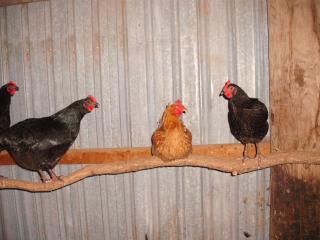Ridgerunner
Garden Master
- Joined
- Mar 20, 2009
- Messages
- 8,241
- Reaction score
- 10,112
- Points
- 397
- Location
- Southeast Louisiana Zone 9A
I dont believe in magic numbers for much of anything to do with chickens. We keep them in so many different circumstances, in so many different climates, with all kinds of different flock make-ups, different chickens handle confinement better than others or just have different personalities, and we manage them so differently that no one number can cover everyone rom Duluth to Miami, Denver to El Paso, Perth to Inverness, small urban backyard to wide open country living. January or July might make a difference too.
The 4 square feet in the coop with 10 in the run per chickens is a rule of thumb pointed more to someone keeping a few hens in an urban backyard. Most of the rules of thumb on BYC are pointed that way. When you get into a lot of chickens those rules kind of break down. They will keep practically anybody out of trouble in most situations but some of them can be overkill. They are OK as a starting point when you dont have any experience to fall back on. Everyone has to start somewhere.
This is going to be a long post anyway so Ill take the time to explain what I mean by the numbers breaking down. This could apply to a lot of the magic numbers you get on BYC but lets look at space. Say you have 4 chickens and you give each one of them 4 square feet for a total of 16 square feet. If each chicken physically takes up 1 square foot, then you have 4 square feet occupied by chickens with 12 square feet unoccupied for them to explore. If instead you have 40 chickens, each with 4 square feet or 160 square feet total available. The have 120 square feet available for exploration. Thats part of the reason that a commercial egg producer can keep 5000 laying hens with only 2 square feet each, though they still have to trim beaks so they dont eat each other.
Dont get too hung up on coop space versus run space. Space is space. It doesnt matter if it is in a coop, coop and run, or if they free range and sleep in trees. If space is available when they are awake, it doesnt matter where it is.
Im an advocate of providing as much space as you reasonably can. In my opinion, there are three reasons to provide adequate space. I find there are fewer behavioral problems if they are not crowded. Behavioral problems could be feather-picking, fighting, all the way to cannibalism.
Chickens have developed ways to live together in a flock. One important way is in case of conflict, the weaker runs away from the stronger or just avoids then in the first place. If they run away, a chase may be involved to drive the message home. They need enough room to get away if they need to or avoid to start with.
I find I have to work less if they are not overly crowded. Poop management is a good example. Chickens poop a lot. If they are packed in tight it builds up. The more it builds up the more effort you have to spend in managing it and the less control you have over that schedule. Im a firm believer that the less often you have to muck out the entire coop the better.
Ill interrupt the regularly schedules program to get into this. You want pure poop for your compost. Use a droppings board to collect pure poop. They poop a lot while on the roost. Collect that stuff. By removing that from your coop the rest of the coop can go longer without being mucked out. Now back to the regularly scheduled program.
The other thing about space is the tighter you pack them the less flexibility you have in managing a problem. Say you pack them in tight then have a predator problem in your run. Can you leave them locked safely in the coop while you handle that problem? Maybe you really need to be somewhere else for a few hours instead of home rebuilding a fence. If you free range them and one hides a nest, one way to handle that is to lock the flock in the coop and run or maybe just coop until she lays her egg, maybe for a week or more, until she learns where she really should be laying that egg. If you ever want a broody to raise chicks with the flock or ever want to integrate new chickens, the more room you have the easier that is. Go back to the room to run away or avoid thing above.
How you manage them is really important. If you just use a coop only as a safe place for them to spend the night and maybe lay an egg, you really dont need much coop space. Two square feet per bird would be plenty, but if you commit to something like this, you commit to letting them out every day of the year at daybreak, when they wake up. You dont sleep in on a Saturday morning, even if you have the flu. If you take a vacation you need to have someone you can rely on to open it at daybreak. I have a college girl that takes care of mine when I go see my granddaughter. If she had to be there at the break of dawn, Id probably be looking for someone else to take care of them. I have enough space so that is not a problem.
How many days will you have that your run space is not available, maybe due to weather? My chickens dont mind cold weather. They go out in zero degrees weather. Thats as cold as it normally gets here or theyd probably go out in colder weather. But they do not like a cold wind. If a cold wind is blowing they find shelter. You might want to provide some type of wind break near your coop. It doesnt take much, just a protected corner so they can get out of the coop if they want to. Having two separate spaces, in the coop and in the run, really helps in that avoid thing.
Mine generally dont like snow at all when they first see it. They generally dont like anything strange and new. But after a couple of days most of mine will go for a stroll in snow. Most, not necessarily all. A few years back a couple of mine waded through 9 of snow to go check out my compost pile. When you are looking at a wind break, you might consider that snow can blow in from the side through a fence. Just something to consider. My protected area is a corner made by the coop and a solid gate. If a cold wind is blowing they are often crowded in there. My coop is big enough for the number of chickens I have in the winter that they can stay in the coop itself if they want to.
It sounds like you are planning on somewhere else for your next Cornish X experience, but what are your plans down the road for this area? Think ahead. How will you add more laying chickens when your current flocks laying rate really drops, which it will in a few years.
With the space you have in West Virginias climate you could easily add another dozen hens, probably another 15 or even 18 without much chance of serious problems. But instead of thinking how many you can shoehorn in this area, maybe think of how many hens you want then make sure you have adequate space?
Ill get back to some of your other questions in a separate post. Others have been posting while I'm typing so I'm way behind.
The 4 square feet in the coop with 10 in the run per chickens is a rule of thumb pointed more to someone keeping a few hens in an urban backyard. Most of the rules of thumb on BYC are pointed that way. When you get into a lot of chickens those rules kind of break down. They will keep practically anybody out of trouble in most situations but some of them can be overkill. They are OK as a starting point when you dont have any experience to fall back on. Everyone has to start somewhere.
This is going to be a long post anyway so Ill take the time to explain what I mean by the numbers breaking down. This could apply to a lot of the magic numbers you get on BYC but lets look at space. Say you have 4 chickens and you give each one of them 4 square feet for a total of 16 square feet. If each chicken physically takes up 1 square foot, then you have 4 square feet occupied by chickens with 12 square feet unoccupied for them to explore. If instead you have 40 chickens, each with 4 square feet or 160 square feet total available. The have 120 square feet available for exploration. Thats part of the reason that a commercial egg producer can keep 5000 laying hens with only 2 square feet each, though they still have to trim beaks so they dont eat each other.
Dont get too hung up on coop space versus run space. Space is space. It doesnt matter if it is in a coop, coop and run, or if they free range and sleep in trees. If space is available when they are awake, it doesnt matter where it is.
Im an advocate of providing as much space as you reasonably can. In my opinion, there are three reasons to provide adequate space. I find there are fewer behavioral problems if they are not crowded. Behavioral problems could be feather-picking, fighting, all the way to cannibalism.
Chickens have developed ways to live together in a flock. One important way is in case of conflict, the weaker runs away from the stronger or just avoids then in the first place. If they run away, a chase may be involved to drive the message home. They need enough room to get away if they need to or avoid to start with.
I find I have to work less if they are not overly crowded. Poop management is a good example. Chickens poop a lot. If they are packed in tight it builds up. The more it builds up the more effort you have to spend in managing it and the less control you have over that schedule. Im a firm believer that the less often you have to muck out the entire coop the better.
Ill interrupt the regularly schedules program to get into this. You want pure poop for your compost. Use a droppings board to collect pure poop. They poop a lot while on the roost. Collect that stuff. By removing that from your coop the rest of the coop can go longer without being mucked out. Now back to the regularly scheduled program.
The other thing about space is the tighter you pack them the less flexibility you have in managing a problem. Say you pack them in tight then have a predator problem in your run. Can you leave them locked safely in the coop while you handle that problem? Maybe you really need to be somewhere else for a few hours instead of home rebuilding a fence. If you free range them and one hides a nest, one way to handle that is to lock the flock in the coop and run or maybe just coop until she lays her egg, maybe for a week or more, until she learns where she really should be laying that egg. If you ever want a broody to raise chicks with the flock or ever want to integrate new chickens, the more room you have the easier that is. Go back to the room to run away or avoid thing above.
How you manage them is really important. If you just use a coop only as a safe place for them to spend the night and maybe lay an egg, you really dont need much coop space. Two square feet per bird would be plenty, but if you commit to something like this, you commit to letting them out every day of the year at daybreak, when they wake up. You dont sleep in on a Saturday morning, even if you have the flu. If you take a vacation you need to have someone you can rely on to open it at daybreak. I have a college girl that takes care of mine when I go see my granddaughter. If she had to be there at the break of dawn, Id probably be looking for someone else to take care of them. I have enough space so that is not a problem.
How many days will you have that your run space is not available, maybe due to weather? My chickens dont mind cold weather. They go out in zero degrees weather. Thats as cold as it normally gets here or theyd probably go out in colder weather. But they do not like a cold wind. If a cold wind is blowing they find shelter. You might want to provide some type of wind break near your coop. It doesnt take much, just a protected corner so they can get out of the coop if they want to. Having two separate spaces, in the coop and in the run, really helps in that avoid thing.
Mine generally dont like snow at all when they first see it. They generally dont like anything strange and new. But after a couple of days most of mine will go for a stroll in snow. Most, not necessarily all. A few years back a couple of mine waded through 9 of snow to go check out my compost pile. When you are looking at a wind break, you might consider that snow can blow in from the side through a fence. Just something to consider. My protected area is a corner made by the coop and a solid gate. If a cold wind is blowing they are often crowded in there. My coop is big enough for the number of chickens I have in the winter that they can stay in the coop itself if they want to.
It sounds like you are planning on somewhere else for your next Cornish X experience, but what are your plans down the road for this area? Think ahead. How will you add more laying chickens when your current flocks laying rate really drops, which it will in a few years.
With the space you have in West Virginias climate you could easily add another dozen hens, probably another 15 or even 18 without much chance of serious problems. But instead of thinking how many you can shoehorn in this area, maybe think of how many hens you want then make sure you have adequate space?
Ill get back to some of your other questions in a separate post. Others have been posting while I'm typing so I'm way behind.




 Betting that by this time next year, BJ's (50+) chickens will be all living in the goat shelter and the goats will be in the smaller coop...
Betting that by this time next year, BJ's (50+) chickens will be all living in the goat shelter and the goats will be in the smaller coop... 
 Boy, did I hear it from Mom.
Boy, did I hear it from Mom.